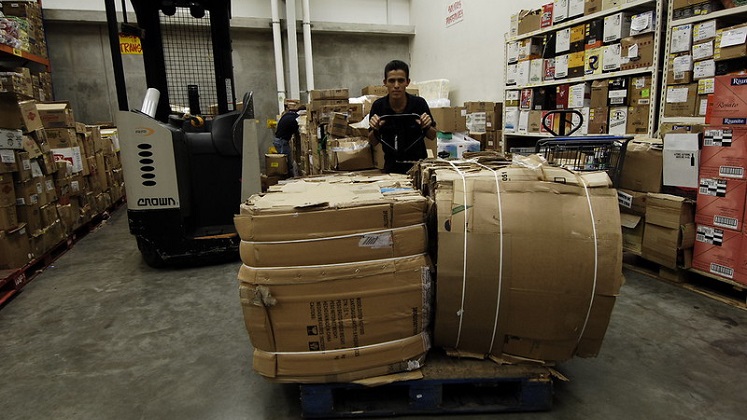 With the right kinds of state support, Latin American firms can develop and compete in productive segments higher up the global value chain, writes Tobias Franz (Universidad de los Andes, Bogotá).
With the right kinds of state support, Latin American firms can develop and compete in productive segments higher up the global value chain, writes Tobias Franz (Universidad de los Andes, Bogotá).
• Disponible también en español
A recent study by CAF–Development Bank of Latin America rightly points out that the misallocation of resources and a high sensitivity to external changes are at the core of Latin America’s structural problems to achieve productivity growth. The vicious cycle of low productivity, a lack of high-skilled labour, and failed commitments to long-term investments have made Latin America the slowest-growing emerging region. To break out of this cycle, the study argues, Latin American leaders need to address internal factors hampering productivity growth, such as the failure in training of a high-skilled labour force, limited access to credit, and a lack of state capacities to overcome institutional barriers and infrastructure gaps.

Despite the important contributions CAF makes to the discussion of factors contributing to Latin America’s productivity problems, the rather generalized and broad guidelines for economic policies might be of little help for Latin American countries in terms of actual policy advice.
In Latin America there are several constraints and challenges that need to be considered in recommending policy strategies that can achieve growth in medium- and high-productivity sectors. The most important is to create and enforce institutional mechanisms that give firms time and room to engage in activities that might otherwise be deemed too risky. This includes investment in researching and learning to use improved technology, as well as investment in vocational education to boost the skills and qualifications of the labour force.
Institutional mechanisms that incentivise or even mandate such investments, thereby underwriting the tacit process of “learning-by-doing”, require states with enough capacity to enforce the conditions necessary for productive outcomes. Governance agencies in particular need to identify sectors that can absorb support for medium- and-high technology leaning. This means that governance agencies must identify those domestic sectors and firms most likely to achieve medium- and high-productivity growth. This policy strategy must include the enforcement of conditions for supported firms to use this technology in productivity-enhancing ways, as well as credible threats of withdrawal if the conditions are not fulfilled. This can help domestic sectors and firms to develop their capabilities and enter productive segments higher up the global value chain.
Another Latin American challenge to the effective implementation and enforcement of these policies is the dominance of elite interests in sectors marked by low productivity. In the past, this has resulted in inefficient resource allocation and failed attempts to climb the productivity ladder. Powerful segments of Latin America’s elite were able to buy political protection, hurting the state’s capacity to credibly withdraw support for unproductive firms. Furthermore, the monopolistic control of productive sectors by a few powerful companies slowed down attempts to increase internal competition. While these power structures largely persist in most Latin American economies, one of the main problems these companies face today is their high dependence on exogenous factors and their vulnerability to external shocks.
This is especially true in the context of a slowdown in international trade (and following the election of Donald Trump), as a reliance on policies that drive Latin America’s integration into the low-productivity end of global value chains will only extend the region’s disappointing and highly volatile growth performances. Furthermore, a continued dependence on cheap labour as a source of global competitiveness will do nothing to overcome Latin America’s minimal technological inventories and static comparative advantages in sectors marked by low productivity and unskilled labour.
In the process of identifying policy areas and ideas for targeting potential productivity-enhancing firms and sectors, Latin American policy makers can learn substantially from the policy experience of other successful middle-income countries, such as South Korea, Taiwan, and Brazil. These countries achieved considerable levels of economic catching-up through specific industrial-policy instruments that supported emerging firms. These instruments had credible conditions, such as export targets which firms had to meet if they were to go on receiving benefits. The implementation and enforcement of these strategies stimulated productivity growth in the supported medium- and high-productivity sectors and created opportunities for wider society. This includes opportunities not just for a few powerful businesses but for all groups of entrepreneurs.

The policy challenges for Latin American countries thus relate to implementation and enforcement of institutional mechanisms that seek to develop the technological capabilities of domestic firms and sectors in order to create medium- and high-productivity outcomes. In the political and institutional context of Latin America, such instruments need to support emerging firms with conditions that can be credibly enforced and withdrawn. While this is a difficult task for policymakers and governance agencies, a rethinking of the region’s economic policy strategies remains possible.
There are three main policy lessons here:
- First, economic policy should focus on identifying technological bottlenecks and establishing appropriate conditions for foreign technology transfers that will create spillovers and linkages which boost technological capability and domestic content creation.
- Second, economic policymakers need to design policies that create incentives and obligations for firms to invest in potential medium- and high- productivity activities. This implies provision of financial and technical support to domestic producers, as well as the improvement of worker’s skills and qualifications.
- And third, implemented mechanisms must place credible conditions on firms that receive support to adapt to new technologies and compete higher up the value chain. Other emerging regions that have implemented such economic strategies were able to achieve considerable levels of economic catching-up.
The Latin American policymakers charged with designing, implementing and enforcing economic policies for the future can and must learn these important lessons as soon as possible.
Notes:
• The views expressed here are of the authors rather than the Centre or LSE
• Please read our Comments Policy before commenting





